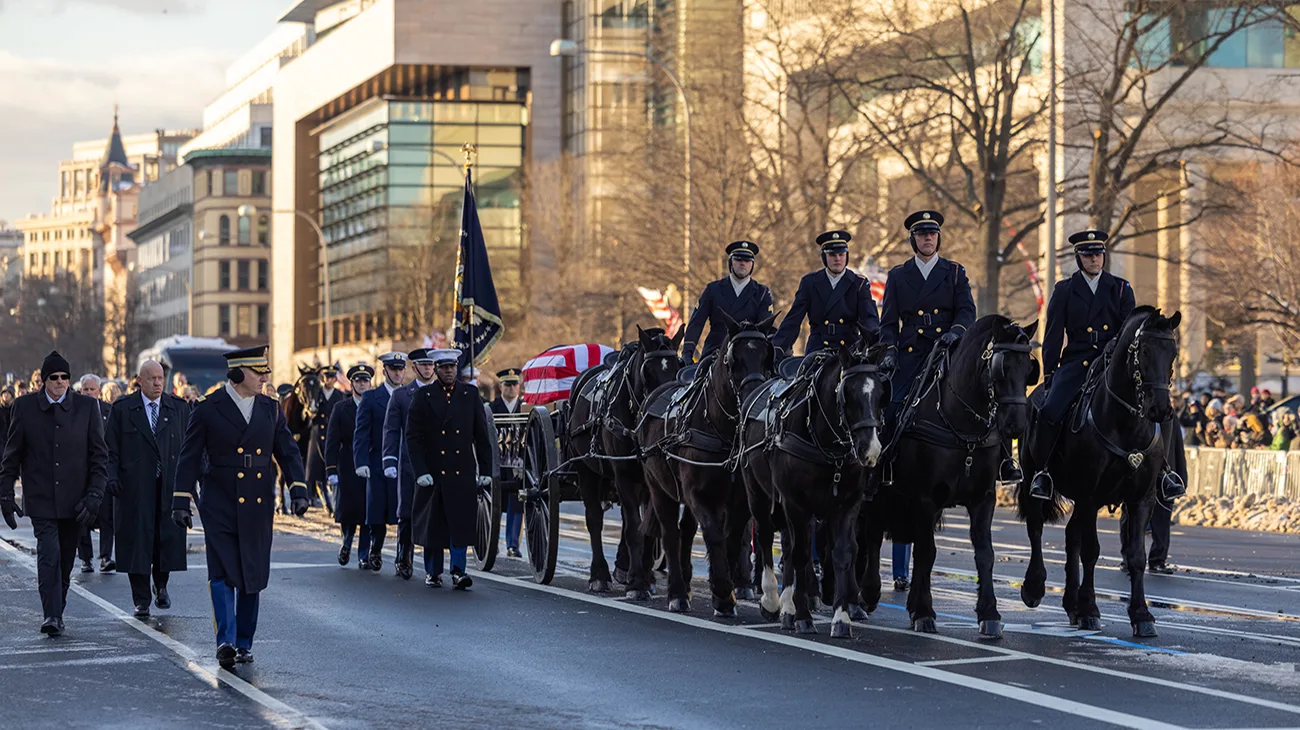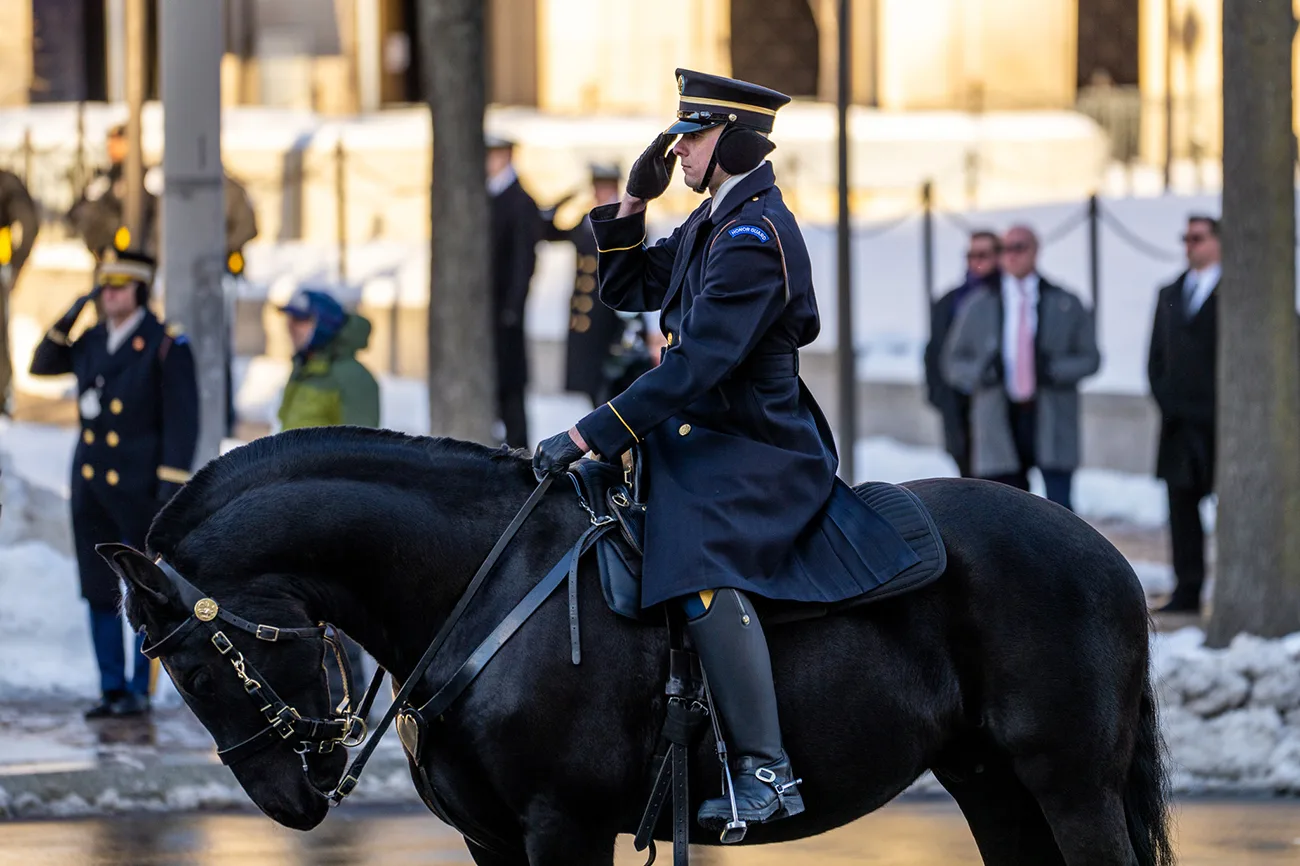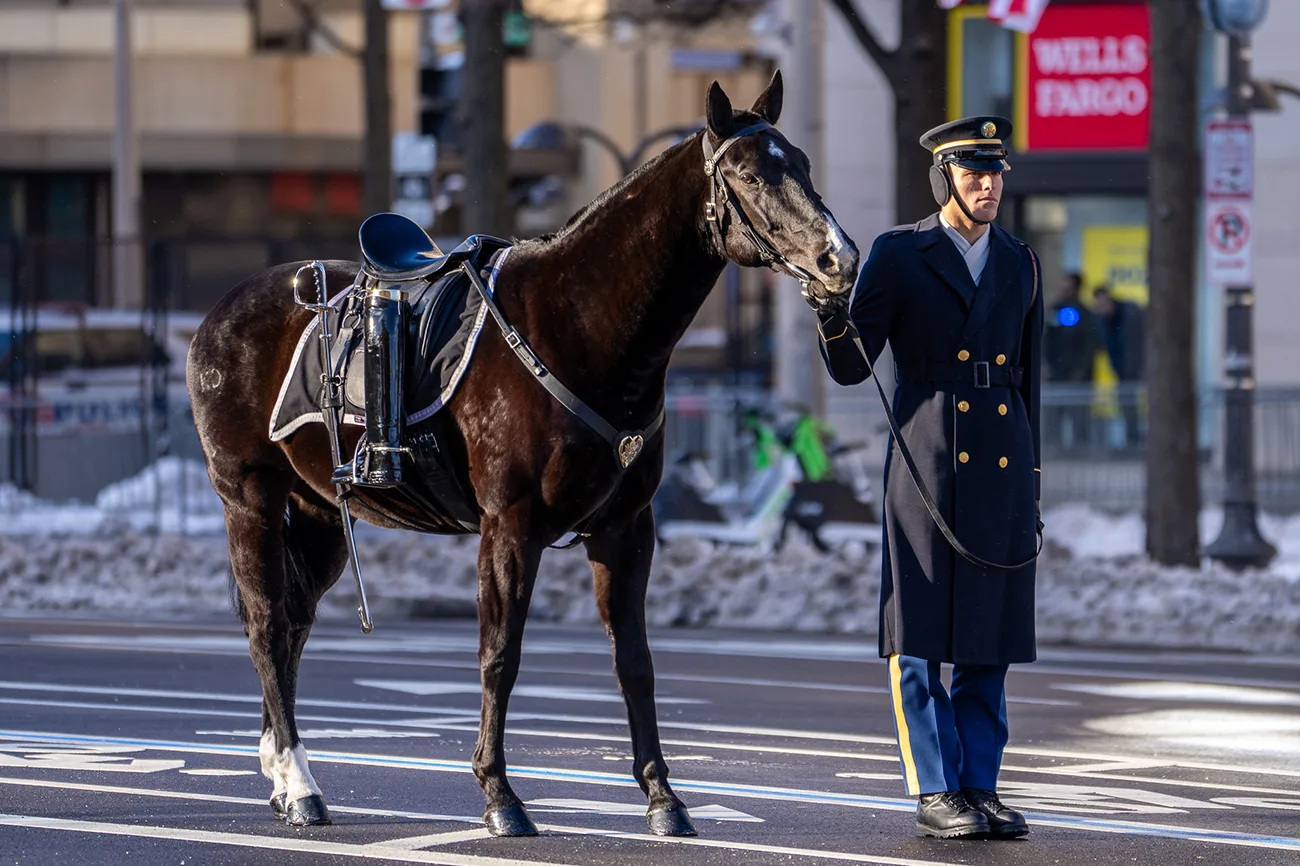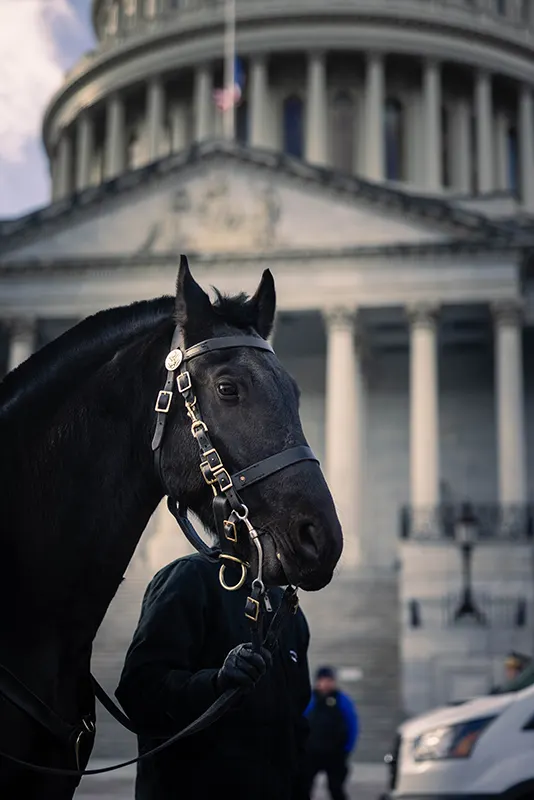Since this article was originally published in the March issue of The Chronicle of the Horse magazine, the Caisson Detachment of the Army’s 3rd United States Infantry Regiment announced that the unit will resume funeral duties in Arlington National Cemetery (Virginia) on June 2. “We are excited to resume the solemn responsibility of escorting our nation’s fallen to their final resting place,” said Maj. Wes Strickland, director of communications for the Army’s Old Guard. “Over the past two years the entire organization has worked to rebuild the program while keeping the horses first and foremost.”
Flipping on the television to watch the state funeral for President Jimmy Carter, it was hard to miss the Caisson Detachment of the Army’s 3rd U.S. Infantry Regiment—the group of soldiers and horses that escort fallen military men and women to their final resting place in Arlington National Cemetery (Virginia) and for state funerals.
What viewers may not have noticed—or taken for granted—was that the procession on Jan. 7 went off without a hitch, thanks largely to work that’s happened behind the scenes to revitalize all aspects of the Caisson program since mid-2023, when the program paused public operations.
As part of their duties, six horses pulled a wagon, called a caisson, bearing Carter’s casket. The horses on the left-hand side were ridden, a style called postilion, and those riders control the team; there is no driver on the wagon. A caparisoned horse—a riderless horse, led by a soldier on foot—also accompanied the caisson with riding boots reversed in the stirrups to symbolize a fallen soldier.

“We’re all excited that they got to do the state funeral,” said Maj. Wes Strickland, director of communications for the Army’s 3rd U.S. Infantry Regiment, also known as The Old Guard. “It was a big coming out party for them in some ways.
“It was kind of like nobody saw us for two years, then we went to the Super Bowl,” he added.
Pressing Pause
In February 2022, two horses in the Caisson unit, Tony and Mickey, died of colic within days of each other, sounding alarm bells about the program. As the spotlight turned to the unit, an investigation revealed that multiple problems— including an aging herd, inadequate living conditions and frequent turnover in leadership—had the program in disarray.
“It was a combination of a lot of different things that got us to where we were,” said Strickland. “Some of those were on the funding side. As funds were focused on certain things over the past 20 years, the Caisson program wasn’t a priority.
“It was on us for not having an understanding of horses,” he continued. “We were just doing things the way we had always done things.”
The Old Guard is the ceremonial unit of the Army and includes the unit responsible for guarding the Tomb of the Unknown Soldier; the Old Guard Fife and Drum Corps (a band that performs in colonial uniforms), and the Presidential Salute Battery (a unit that fires cannon salutes to honor the U.S. president and other dignitaries, among other groups). The Old Guard falls under the purview of Maj. Gen. Trevor Bredenkamp, the commanding general of the Joint Task Force—National Capital Region. According to Strickland, the program is written into law and cannot be disbanded, though it is dependent on Congress for funding.
Retired Navy Rear Adm. Jon Kreitz, a lifelong horseman who also serves on the U.S. Equestrian Federation board of directors, laid out the problem in his opening statement to the U.S. House of Representatives Committee on Veterans’ Affairs Subcommittee on Disability Assistance and Memorial Affairs during a November 2024 oversight hearing on the topic.
“Why did our Army get to this point where it has been unable to execute the caisson mission for nearly two years?” he said. “Historically, the military took care of their horses as they did any other soldier, because to do otherwise invites failure on the battlefield. Today’s military takes care of its canine, carrier pigeon and dolphin soldiers, but over the past 25-plus years has lost the intrinsic knowledge of how to care for the equine soldier.
“The failures stem from ill-informed human priorities for land management and training, not the weight of the caisson, style of saddle, cobblestone aisleways or color of horse,” he added later. “Photographs and posted videos over the last 25 years show ill-fitted tack and dangerous training practices, not with evil intent, but from ignorance and a lack of cognizant oversight.”

In the spring of 2023—after the deaths of two additional horses—the Caisson program was suspended for six weeks for evaluation, and when officials realized the system needed an overhaul, the moratorium continued.
But who could help get it back on track?
Contacting The Experts
At the end of December 2023, the Army reached out to the USEF through Kreitz, inviting representatives to a symposium featuring experts from across the horse industry, including top veterinarians and experts in tack, nutrition, training and driving.
Individual Olympic gold medalist and USEF Chief of Sport David O’Connor was asked to give a presentation on social license to operate, as by then there had been multiple articles in the press detailing the program’s failings. Leaders were so impressed that they asked O’Connor to come on as a consultant, or as the Army calls them, a “highly qualified expert,” to help design a syllabus for a 12-week basic horsemanship class for new recruits.
“It was a great exercise to think about, because it’s been a while since I learned all that,” said O’Connor. “For somebody that doesn’t know horses at all, where do you start? Besides going over anatomy and care and feed and what horses need, and a little bit about the basics of how they think, we included, ‘How do you approach them? How do you put on a halter? What is the tack? How does it work? How do horses work?’ It’s like what we used to do in Pony Club when we were kids.”
Driving expert Josh Minshull, general manager and lead driver for Express Clydesdales in Yukon, Oklahoma, was at that summit as well, and he recruited fellow driving guru Jim Westbrook and 21-time USEF advanced four-in-hand driving national champion Chester Weber to help with a March 2024 three-day hitch clinic, evaluating soldiers’ horsemanship and horses for rideability and drivability.
Weber said that everyone was cognizant of the fact that Carter was in hospice care, and they wanted a squad to be ready in case of a state funeral.
ADVERTISEMENT
“By the end of that they said, ‘Wow, you have quite a methodical approach. Do you think you could help us? Could you come and help us make a group of horses ready here?’ ” said Weber. “I said, ‘I can’t do that here in Washington, D.C.’ But I said if they came to Ocala, I could probably figure that out.”
A week and a half later, nine horses and 12 to 15 soldiers showed up with staff sergeants at Weber’s Live Oak Plantation in Ocala, Florida, for training. Weber and his team worked closely with the soldiers and horses for six weeks, and three evenings a week the soldiers joined Weber’s niece, FEI show jumper Chloe Reid, for workouts targeted toward riding.
Weber said he felt especially qualified to help the unit; he owns five funeral homes, which have sent people to Arlington Cemetery, and he understands the solemnity and importance of the mission.
At the end of the immersive training in Ocala, the squad went back to their base at Fort Myer in Arlington, Virginia, to validate—that is, demonstrate readiness—for a state funeral.
“The Army band is there; they do a 21-gun salute,” said Weber. “Horses have to be able to pass a series of tests that are fair and reasonable to exhibit their preparedness to work.”

Since then, two additional squads have gone through the basic horsemanship program and then hands-on driving training at Live Oak and are undergoing continuing education in Virginia.
“What we’ve realized is some of the immersion is necessary to be able to get the synergy between the soldiers and the horses, because they come down here, and for six weeks they’re living with these horses as their only job,” said Weber. “There’s no distraction of date night or anything like that. I’m super proud of what they’ve all been able to digest, and the intensity of two-a-days, doing equitation work and then caisson or postilion work, six days a week, makes for a situation where horses and riders are developed very well.”
In addition to updating their training, the team behind the revitalization of the program recognized that the horses’ stabling situation was insufficient, and the main barn at Fort Myer, located next to Arlington National Cemetery, is under construction.
The stalls are being enlarged, and the historic brick that lines the floor of the barn is being replaced with rubberized footing. The paddocks are getting reworked and drainage issues addressed, and a second barn is due to undergo a revamp there as well. Strickland said the team has leaned heavily on experts like O’Connor for advice with the barns.
“When the guy standing there is saying, ‘In Paris [at the Olympics] this year, this is how we did it,’ it’s helpful,” said Strickland.
“When the guy standing there is saying, ‘In Paris [at the Olympics] this year, this is how we did it,’ it’s helpful.”
Maj. Wes Strickland
The longer-term plan is for the Army to build its own equestrian center within driving distance of Arlington, where the horses will live and train, and they’ll just go to the smaller facility at Fort Myer for a week at a time to work. But in the meantime, the horses moved an hour west in 2023 to Aldie, Virginia, where they are stabled at Paula Joyce’s NOVA Equestrian Center, a 50-acre boarding and training facility with lots of room for turnout and training.
“Initially they went out there for the space and facilities to be able to rehabilitate and get them healthy again,” said Strickland. “We’re light years beyond that now. We’re in the conditioning side of things. They can work and train and be more like a professional sports team.”
Adapting To Modern Times
In addition to upgrading the facilities and training programs for horses and riders, there’s the matter of equipment and the horses themselves.
Western saddle brand Circle Y designed a McClellan saddle, a style traditional for the Army, and each horse now has their own custom-fit version. Then Weber gave advice on modernizing the harnesses used in the program.
“We ended up coming up with a design of harness and perfecting it, so that it would be the most ergonomic and comfortable for the horses to do the job [and] would also look like a traditional harness,” he said. “[The Army’s] needs were different. You can’t find a postillion harness just anywhere, so we ended up working to design a harness that had a familiar look to the traditional one, because The Old Guard fundamentals are rooted in traditions.”
To explain the necessity of custom harnesses, Weber used a comparison familiar to the Army.
“The analogy I used was combat boots,” he said. “If you imagine, [the original] harness is out of a manual which is from the Civil War era. My thought process was, ‘How would soldiers do in Civil War-era combat boots?’ I said, ‘What are combat boots like today?’ They said, ‘Well, they look like combat boots, but they’re more like Nike running shoes as far as technology and fit and things like that.’
“Everybody agreed we could take some of the weight out of the harness and use some materials, like memory foam, which are available to ensure the most comfortable fit for the horse to be able to do their job,” he continued. “We also brought in some aspects to complement safety technology available as well. We did that successfully, and we’ve been working on that, as well with the caissons, to ensure that the balance of them is correct, and that they roll correctly while still having a very traditional look of a carriage that has roots to pre-World War I.”
The previous caissons weighed about 2,400 pounds each; the new ones are about 1,000 pounds less. That’s a big change, especially considering that Arlington Cemetery is quite hilly.
Then there are the horses. Since 2023 dozens of aging horses from the program have been retired to the farm of Mary Roberts, of the Roberts family’s World Equestrian Center, who volunteered to take them. New horses have been acquired; they’re mostly draft crosses, but there are Friesians, Quarter Horses and even a mustang in the program. Strickland estimates that there are about 35 horses in the program currently, with the goal of 60 total.
ADVERTISEMENT
Minshull helped procure some of the first horses to join the unit, and Westbrook also has been instrumental in tracking down potential horses, which, in addition to being appropriate for the job, must be black. Previously the caisson program also had a gray team, but when those horses retired, officials decided to stick with all black horses so it’s easier to substitute horses in as necessary.
“Horses are supposed to be the same color, so we don’t have a kaleidoscope of horses out there,” said Strickland. “It would look odd if we had a ceremony with a bunch of different uniforms.”
But just being the right color isn’t nearly enough. Caisson horses must have the right temperament and ability to learn, with fundamental flatwork skills including the ability to neck-rein, and they must be able to drive in multiples up to a six-horse hitch. Horses undergo extensive desensitization training to get used to marching bands, flags, flyovers and ceremonial cannon fire. O’Connor compared the poise soldiers must maintain while riding the Caisson horses to that required of dressage riders.

“Soldiers sitting on the horses have to maintain what we call ceremonial composure,” explained Strickland. “They can’t talk to the animals or ease them in any way, other than being physically there. There’s probably some micro-movements with their legs and things like that to give the horses a sense of security, but if you can imagine being hitched to five other horses and then a huge wagon, and you have one of your horses start to act up and not being able to move—the horses have to be very conditioned to be very comfortable. It takes a very special type of horse.”
One problem the Army is still grappling with is recruiting horsemen to join the Caisson Detachment. Soldiers assigned to The Old Guard have the opportunity to try out for the Caisson Unit, but few have previous horse experience. There are efforts to change that, both by recruiting horsemen to join the Army and by recruiting soldiers already enlisted who have horse experience to come join the group.
“Turnover is something that we as a military are constantly dealing with,” said Strickland. “On the horsemanship side, this creates additional challenges, especially considering that many of our soldiers have little to no background with horses before they join the Caisson Detachment. We are working on ways that we can extend their time with us to provide some additional stability to the program and other alternatives in the future that would keep soldiers here much longer. I think this is why we’ve put such an emphasis on our training program.”
Leading The Way
There are a handful of other equine units in the Army, including the Horse Cavalry Detachment at Fort Cavazos in Texas that participates in cavalry reenactments, and a smaller caisson team at West Point Military Academy (New York). But The Old Guard’s Caisson Detachment is by far the most public program.
“The idea behind a military equine program is that the changes and implementations that we do here will have trickle-down effect on other equine programs throughout the Army,” said Strickland. “Things we’re learning would be codified and shared across the enterprise to help advance equine care throughout the Army.”
“I think there are a lot of people in it completely, completely for the right reasons, trying to get the program up and sustainable, so it will last for decades for the future.”
David O’Connor
The fact that much of modern equestrianism has military roots, and now civilians are helping the military learn horsemanship, isn’t lost on O’Connor. Military equestrians—like Brig Gen. Harry Chamberlin, who wrote classics like “Riding And Schooling Horses” and “Training Hunters, Jumpers, And Hacks” and competed at three Olympic Games, winning team eventing gold and team and individual jumping silver in 1932 in Los Angeles—once had an outsized influence on horsemanship in the United States and beyond. After the disbanding of the U.S. Cavalry in the 1940s, horses became less a part of military life.
“The Army kept going through the 1950s with having their own horses, but there weren’t regiments of horses or education programs for general cavalry people like they had in the ’20s and ’30s at Fort Riley,” said O’Connor.
“With that, a lot of the education had disappeared, because there’s not a lot of horse people in the Army anymore. So it’s just re-creating an education system so people can hopefully be there for a while and promote a program that I think is very important.”
Carter’s state funeral represented the revitalized program’s debut, though the Caisson Detachment has not yet returned to Arlington Cemetery. Bredenkamp has been a driving force behind reforming the Caisson unit, and he’s adamant that the unit not return to Arlington until it is prepared.
“Some of that is building back squads and teams we need,” said Strickland. “Some is dependent on Arlington. What sort of capacity do they require? At one point they were doing eight services a day with the Caisson. Do we go back to that, or go back to four, or start with two, and build it back? A lot of this is being discussed to figure out what that looks like.
“We all wanted to get back into getting the mission started again in the cemetery, but we want to make sure that when we start it’s really in a [good] place,” he continued. “The general has been adamant about that—that when we go, we go. There’s no backsliding or, ‘Oh no, we need to stop again.’ ”
Looking ahead O’Connor said that he plans to work with the Army officials to design an intermediate horsemanship course and eventually an advanced instructor one.
“I think there are a lot of people in it completely, completely for the right reasons, trying to get the program up and sustainable, so it will last for decades for the future,” said O’Connor. “That’s what you’re looking for. There are short-range things you have to think about, but long-range sustainability is a big part of this priority. I hope to celebrate it for decades to come.”
This article originally appeared in the March 2025 issue of The Chronicle of the Horse. You can subscribe and get online access to a digital version and then enjoy a year of The Chronicle of the Horse. If you’re just following COTH online, you’re missing so much great unique content. Each print issue of the Chronicle is full of in-depth competition news, fascinating features, probing looks at issues within the sports of hunter/jumper, eventing and dressage, and stunning photography.














